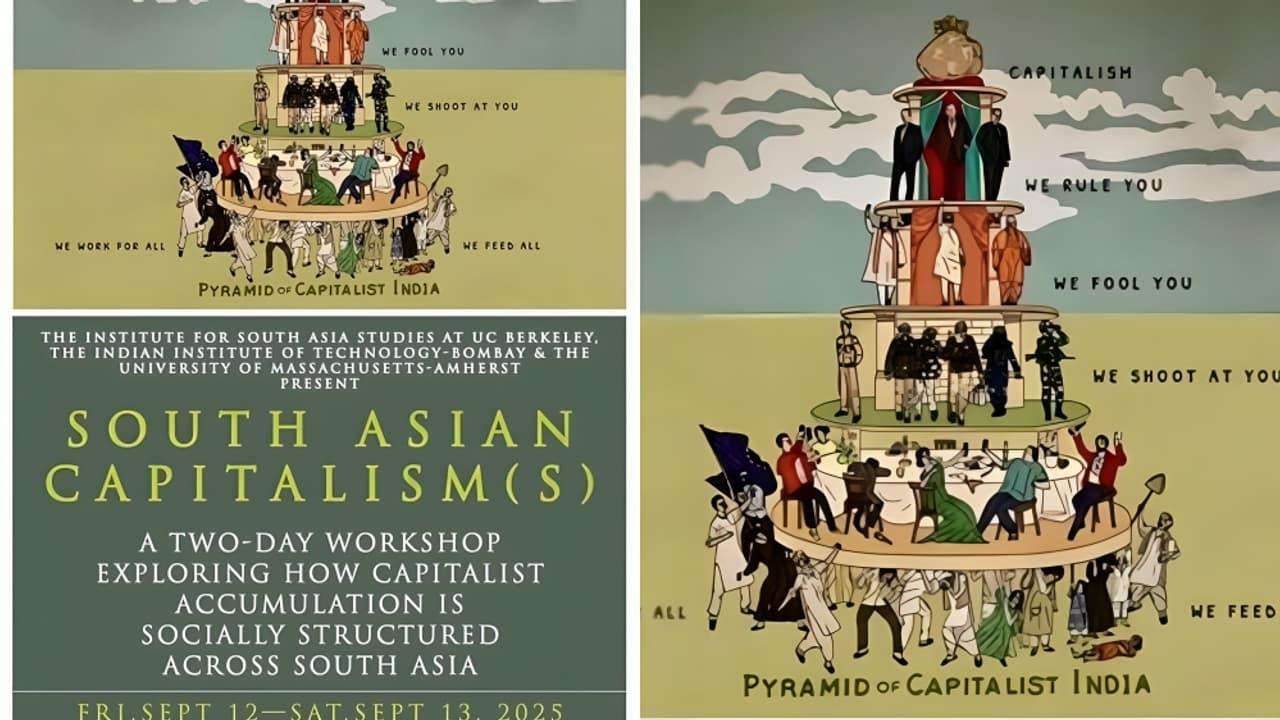'We Fool You': IIT Bombay Poster On Pyramid Of Capitalism Mocks Indian Leaders, Sparks Controversy
A workshop poster co-hosted by IIT Bombay, UC Berkeley and the University of Massachusetts Amherst has drawn widespread criticism for depicting India's top elected leaders under the 'We Fool You' tier of a historic anti-capitalist pyramid, sparking debate about politics, free speech and the role of humanities in technical institutes.
IIT Bombay sponsors an event on South Asian Capitalism shows @AmitShah, @narendramodi, and @myogiadityanath with a caption“WE FOOL YOU”.No Maulana or Father shown; only a Hindu Monk in saffron robes. Why @iitbombay? @dpradhanbjp twitter/6YzByZtXrp
- Harshil (હર્ષિલ) (@MehHarshil) September 10, 2025
The event, titled South Asian Capitalism(s), is scheduled for September 12-13, 2025, at UC Berkeley's Stephens Hall. It aims to explore how capitalist accumulation is socially structured across South Asia. The poster adapts the iconic 1911 Pyramid of Capitalist System, originally published by the Industrial Workers of the World, which illustrated how workers formed the base of society, supporting soldiers, clergy and elites, with a bag of money crowning the pyramid.
The anti-capitalist pyramid
The original graphic conveyed a clear message: societal structures depend on the labor of workers and if that labor were withdrawn, the hierarchy would collapse. In the 1911 version, the second tier labelled 'We Fool You' included clergy from multiple denominations, representing religion's role in legitimizing inequality.
In the IIT Bombay-linked poster, however, the 'We Fool You' tier allegedly replaces clergy with Prime Minister Narendra Modi, Home Minister Amit Shah, and Uttar Pradesh Chief Minister Yogi Adityanath, says a viral X post. The poster is titled Pyramid of Capitalist India and positions elected leaders as those misleading or controlling the public, drawing sharp reactions from political supporters and sections of the public.
IIT Bombay poster draws backlash
Online backlash quickly followed. Twitter users, including @MehHarshit, criticised the replacement of religious figures with Hindu leaders, saying, "No Maulana or Father shown; only a Hindu Monk in saffron robes. Why @iitbombay?” Others accused IIT Bombay of partisan bias, demanding accountability for using public funds to sponsor the event. Some called for the removal of humanities departments from technical institutes, arguing that scientific centers should remain neutral and free of ideological influence.
The poster also depicts the base of the pyramid with workers and farmers, reflecting the classic imagery of labor supporting the hierarchical system. The middle tiers show military, political, and elite groups benefiting from the labor below. The top features a bag of money symbolizing capitalist accumulation, staying true to the original 1911 concept.
History of Pyramid of Capitalist System
The Pyramid of Capitalist System has a long history. The 1911 American version drew inspiration from a 1901 Russian caricature showing the Tsar, clergy, and army atop a laboring population. Both versions included a child lying at the base, symbolizing the human cost of inequality, and a red flag representing emerging socialist movements. Over time, the imagery became a global symbol of class critique and has inspired various adaptations across countries and contexts.
While the IIT Bombay poster maintains the core anti-capitalist critique, its specific choice of contemporary Indian leaders sparked a fresh debate over academic freedom, political satire, and institutional responsibility. The organizers, including UC Berkeley, IIT Bombay and UMass Amherst, have not yet provided an official comment, but the event remains advertised as free and open to the public.
Such imagery often generates controversy when modern political figures are directly associated with historical critiques. While critics argue it crosses into partisan territory, defenders of academic freedom highlight the importance of debate, critique and public discourse within universities. The event also touches upon broader questions about funding, the humanities' place in technical education and the balance between free expression and political sensitivity.
Legal Disclaimer:
MENAFN provides the
information “as is” without warranty of any kind. We do not accept
any responsibility or liability for the accuracy, content, images,
videos, licenses, completeness, legality, or reliability of the information
contained in this article. If you have any complaints or copyright
issues related to this article, kindly contact the provider above.
Most popular stories
Market Research

- Japan Buy Now Pay Later Market Size To Surpass USD 145.5 Billion By 2033 CAGR Of 22.23%
- BTCC Summer Festival 2025 Unites Japan's Web3 Community
- GCL Subsidiary, 2Game Digital, Partners With Kucoin Pay To Accept Secure Crypto Payments In Real Time
- Smart Indoor Gardens Market Growth: Size, Trends, And Forecast 20252033
- Nutritional Bar Market Size To Expand At A CAGR Of 3.5% During 2025-2033
- Pluscapital Advisor Empowers Traders To Master Global Markets Around The Clock






















Comments
No comment